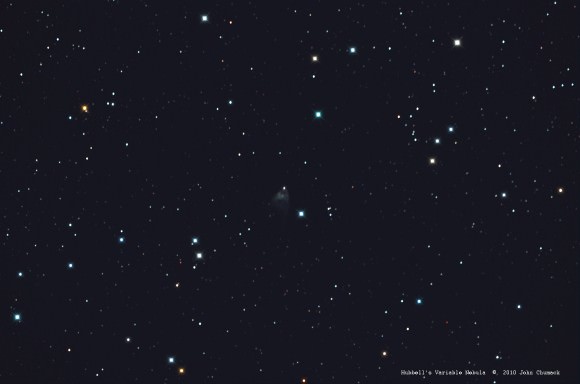Greetings, fellow SkyWatchers! It’s a dark weekend and time to get out and rock the night… If you’re up to the challenge, one of the finest and most exciting objects we’ll study here isn’t a Messier… it’s a comet. And not just any comet – but one that fits right into this time frame in history! Not up to hunting a moving object? Then we’ll take a look at two objects that could resemble comets and not only present a challenge, but add to the fun! Whenever you’re ready, dust your optics off and I’ll see you in the backyard….
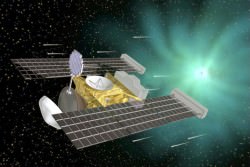 January 15, 2010 – In 2006, Stardust was nearing Earth with its payload of cometary dust particles from Comet Wild 2. The tiny interstellar dust particles were collected by the spacecraft Stardust, which on January 15, 2006, completed its 7-year Odyssey in space by returning its samples to Earth. Two years before, on January 2, 2004, Stardust flew through the hail of rocks and dust that make up comet Wild 2’s coma, collecting invaluable samples of cometary particles that will help scientists decipher the history of our solar system. But during its long voyage Stardust also picked up a different type of sample — minuscule particles of interstellar dust that arrived at our solar system from distant stars, light years away. Stardust collected these particles between February and May 2000, and again between August and December 2002, while passing through a stream of dust that flows into our solar system from interstellar space. The stream was discovered quite recently — in 1993 by the spacecraft Galileo, which passed through that region of space on its way to Jupiter. When Stardust flew through the stream, it extended its tennis-racket shaped aerogel collector, picking up and storing the interstellar particles. No such pristine particles from distant stars have ever been collected before! Then, on January 15, 2006, Stardust swung by the Earth once more and released a sample return capsule, which parachuted safely down onto the Utah desert. Nestled within the capsule’s science canister were two sets of samples: cometary particles on one side of the aerogel collector, and interstellar dust on the other. Within days of arrival, mission scientists began extracting the dust grains from Wild 2 and preparing them for shipment to scientists around the world. Don’t forget to participate in StarDust@Home!
January 15, 2010 – In 2006, Stardust was nearing Earth with its payload of cometary dust particles from Comet Wild 2. The tiny interstellar dust particles were collected by the spacecraft Stardust, which on January 15, 2006, completed its 7-year Odyssey in space by returning its samples to Earth. Two years before, on January 2, 2004, Stardust flew through the hail of rocks and dust that make up comet Wild 2’s coma, collecting invaluable samples of cometary particles that will help scientists decipher the history of our solar system. But during its long voyage Stardust also picked up a different type of sample — minuscule particles of interstellar dust that arrived at our solar system from distant stars, light years away. Stardust collected these particles between February and May 2000, and again between August and December 2002, while passing through a stream of dust that flows into our solar system from interstellar space. The stream was discovered quite recently — in 1993 by the spacecraft Galileo, which passed through that region of space on its way to Jupiter. When Stardust flew through the stream, it extended its tennis-racket shaped aerogel collector, picking up and storing the interstellar particles. No such pristine particles from distant stars have ever been collected before! Then, on January 15, 2006, Stardust swung by the Earth once more and released a sample return capsule, which parachuted safely down onto the Utah desert. Nestled within the capsule’s science canister were two sets of samples: cometary particles on one side of the aerogel collector, and interstellar dust on the other. Within days of arrival, mission scientists began extracting the dust grains from Wild 2 and preparing them for shipment to scientists around the world. Don’t forget to participate in StarDust@Home!
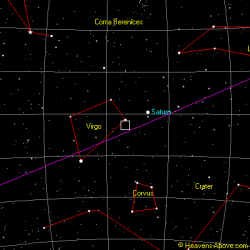 If you’d like to collect a little “stardust” of your own, then this weekend is a great opportunity to actually view Comet 81P Wild 2! Holding a near respectable magnitude 10 and cruising through Virgo (rough RA 13 10.7 and DEC -04 48). 81P Wild 2 has a distant and circular orbit which has it about 1.642 AU away from our Sun at the moment and it will continue to brighten slowly over the next couple of months and is expected to be its brightest (magnitude 9) towards the end of March and in early April. While Comet 81P Wild 2 is just a bit too faint to be found with average binoculars, even a small telescope will reveal its diffuse form. It won’t be bright, and it will appear more like a small, round nebulous patch rather than what folks traditionally think of as a comet… But history is out there waiting on you to come and collect on history!
If you’d like to collect a little “stardust” of your own, then this weekend is a great opportunity to actually view Comet 81P Wild 2! Holding a near respectable magnitude 10 and cruising through Virgo (rough RA 13 10.7 and DEC -04 48). 81P Wild 2 has a distant and circular orbit which has it about 1.642 AU away from our Sun at the moment and it will continue to brighten slowly over the next couple of months and is expected to be its brightest (magnitude 9) towards the end of March and in early April. While Comet 81P Wild 2 is just a bit too faint to be found with average binoculars, even a small telescope will reveal its diffuse form. It won’t be bright, and it will appear more like a small, round nebulous patch rather than what folks traditionally think of as a comet… But history is out there waiting on you to come and collect on history!
 January 16, 2010 – In 1978 on this date, NASA named 35 candidates for space shuttle missions, including Sally Ride as the first female U.S. astronaut and Guion Bluford, Jr., as the first black. In 1973, the Lunokhod 2 mission was beginning its robotic lunar expedition, and in 1969 Soyuz 4 and 5 became the first vehicles to dock in space and exchange cosmonauts. The year 1730 saw the birth of Jean Bochart – publisher of LaPlace’s planet/ecliptic theory. Although eventually beheaded for his politics, Bochart put together Europe’s largest collection of astronomical instruments and was renowned for his calculations of cometary orbits, made jointly with long-time friend and co-observer Charles Messier.
January 16, 2010 – In 1978 on this date, NASA named 35 candidates for space shuttle missions, including Sally Ride as the first female U.S. astronaut and Guion Bluford, Jr., as the first black. In 1973, the Lunokhod 2 mission was beginning its robotic lunar expedition, and in 1969 Soyuz 4 and 5 became the first vehicles to dock in space and exchange cosmonauts. The year 1730 saw the birth of Jean Bochart – publisher of LaPlace’s planet/ecliptic theory. Although eventually beheaded for his politics, Bochart put together Europe’s largest collection of astronomical instruments and was renowned for his calculations of cometary orbits, made jointly with long-time friend and co-observer Charles Messier.
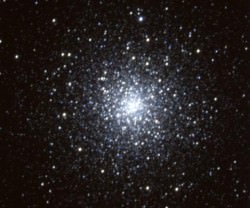 Tonight, venture into Lepus for a faint, round, fuzzy object that might easily be mistaken for a comet in a small telescope or binoculars – Messier Object 79 (RA 05 24 10 Dec +24 31 27). The true beauty of this object is revealed in large telescopes. Behold a globular cluster, one of many densely packed balls of stars that mainly congregate near our galactic center. Discovered by Pierre Mechain and cataloged by Messier in 1780, M79 is on the opposite side of our galaxy, and about 4,200 light-years away. Spanning 118 light-years, this starry sphere may not be an original member of our galaxy at all but an import. Although we can’t see it happening, the Canis Major Dwarf galaxy is slowly being incorporated into our own system, and M79 might very well be a product of this union!
Tonight, venture into Lepus for a faint, round, fuzzy object that might easily be mistaken for a comet in a small telescope or binoculars – Messier Object 79 (RA 05 24 10 Dec +24 31 27). The true beauty of this object is revealed in large telescopes. Behold a globular cluster, one of many densely packed balls of stars that mainly congregate near our galactic center. Discovered by Pierre Mechain and cataloged by Messier in 1780, M79 is on the opposite side of our galaxy, and about 4,200 light-years away. Spanning 118 light-years, this starry sphere may not be an original member of our galaxy at all but an import. Although we can’t see it happening, the Canis Major Dwarf galaxy is slowly being incorporated into our own system, and M79 might very well be a product of this union!
Thanks to Mechain and Messier’s careful notes, William Herschel later recovered M79 and resolved its stars. Although the practice of maintaining an astronomy diary isn’t for everyone, keeping simple records is very rewarding. Make note of the object’s appearance, equipment used, and sky conditions. Observing diaries just like those of Messier and Mechain have led countless astronomers along the road of discovery to all the deep-sky objects we know today!
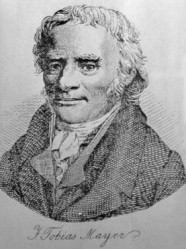 January 17, 2010 – Celebrate the 1723 birthday of Johann Tobias Mayer, the German astronomer who created the first lunar tables for determining longitudes at sea. His calculations were accurate to within a half degree! Mayer was also the first to develop the “reflecting circle” – a complete circular instrument graduated to 720°. The reflection circle was a welcome addition, because at the time the technology did not had enough accuracy for surveying measurement. To reduce the error, they relied on making the average of three sequential readings over the circle, separated 120º from each other. A very cool instrument that preceded the sextant!
January 17, 2010 – Celebrate the 1723 birthday of Johann Tobias Mayer, the German astronomer who created the first lunar tables for determining longitudes at sea. His calculations were accurate to within a half degree! Mayer was also the first to develop the “reflecting circle” – a complete circular instrument graduated to 720°. The reflection circle was a welcome addition, because at the time the technology did not had enough accuracy for surveying measurement. To reduce the error, they relied on making the average of three sequential readings over the circle, separated 120º from each other. A very cool instrument that preceded the sextant!
Are you ready for one last cometary object? Then get out there and capture NGC 2261 (RA 6:39.2 Dec +08:44). You’ll find it about 2 degrees northeast of star 13 in Monoceros. Perhaps you know it better as “Hubble’s Variable Nebula”?
Named for Edwin Hubble, this 10th magnitude object is very blue in appearance through larger apertures, and a true enigma. The fueling star, the variable R Monocerotis, does not display a normal stellar spectrum and may be a proto-planetary system. R is usually lost in the high surface brightness of the “comet-like” structure of the nebula, yet the nebula itself varies with no predictable timetable – perhaps due to dark masses shadowing the star. We do not even know how far away it is, because there is no detectable parallax!
Until next week? Keep your feet on the ground and your eyes on the skies! There’s even more about to happen…
This week’s awesome images are (in order of appearance): Artist’s conception of the Stardust spacecraft Credit: NASA / JPL , Sally Ride – Credit: NASA, M79 Credit: NOAO/AURA/NSF, Johann Tobias Mayer (historical image) and the Hubble Variable Nebula by John Chumack. We thank you so much!!


